As I looked at my first Rhinoceros in the wild, overwhelmed with joy, I wondered if this one was born in Manas, or among those brought in from Kaziranga and Pobitora. Since the 1990’s when there were no Rhinos left in Manas, to 2019, with a stable population on the rise, the national park seems safe and sound for these species. The Indian Rhino Vision began Rhino translocation in Manas with 18 Rhinos in 2008 and 8 more were moved by the Centre for Wildlife Rehabilitation and Conservation. This has now resulted in a population of 32 in Manas National Park.
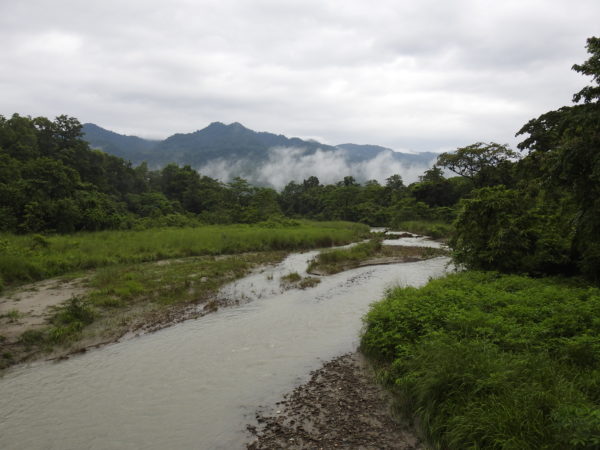
Manas National Park
Indian Rhino Vision (IRV) 2020 is a partnership among the Government of Assam, the International Rhino Foundation, the World Wide Fund for Nature, the Bodoland Territorial Council, and the U.S. Fish & World Wildlife foundation. The project is an ambitious effort to attain a wild population of at least 3,000 greater one-horned Rhinos spread over seven protected areas in the state of Assam by the year 2020. This is being done by moving Rhinos from overcrowded areas like Kaziranga National Park and Pabitora Wildlife Sanctuary, to other protected areas such as Manas, where they can breed. Supplemented with strict protection and community engagement, they seem to be adapting well. Although there have been instances of poaching in the past, the focus has always been on improving security, since the situation has been improving. The park authorities have actively been assisting the IRV partnership.
Manas National Park is home to some of the most threatened animals, which continue to thrive. During monsoon, the National Park is closed off for most tourists due to heavy rains. Other parts of Assam, especially Kaziranga National Park experience heavy floods. However, maybe due to the location and terrain in Manas, which is mostly flat, with small hilly areas towards Bhutanese Himalayas, floods do not seem to affect this region drastically.
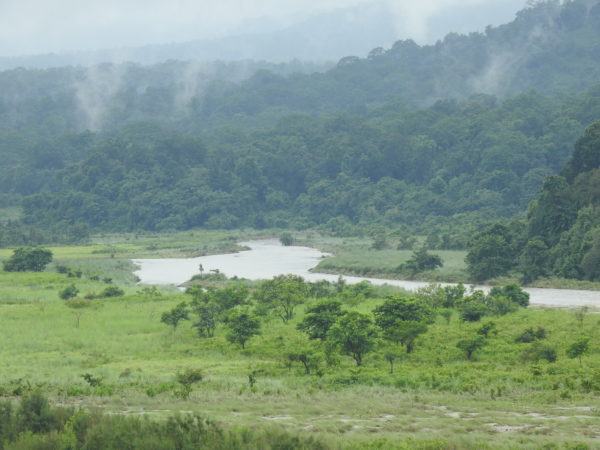
Bhutan's Royal Manas National Park on the other bank of River Manas
Located in the foothills of the Himalayas, this park shares its borders with Bhutan’s Royal Manas National Park. The River Manas acts as the border dividing these parks. Manas National Park was a reserved forest in the past, but later recognized as a UNESCO World Heritage Site (Natural) in 1985, and a national park in 1990. The Park provides habitat for 22 of India’s most threatened wild animals listed in Schedule 1 of India’s national Wild Life (Protection) Act 1972. Manas is world-renowned for its rich variety of both flora and fauna. The protected area includes a range of forested hills, grasslands and evergreen forests as well. The wildlife here ranges from endangered species, including the Bengal Tiger, Greater One-horned Rhinoceros, Swamp Deer, Assam Roofed Turtle, Pygmy Hog, Bengal Florican, Golden Langur and the only pure strain of Asiatic Wild Buffalo; to other animals such as Elephant, Leopard, Clouded Leopard, Himalayan Bear, Wild Boar, Sambar, Hog Deer, Capped Langurs, etc.
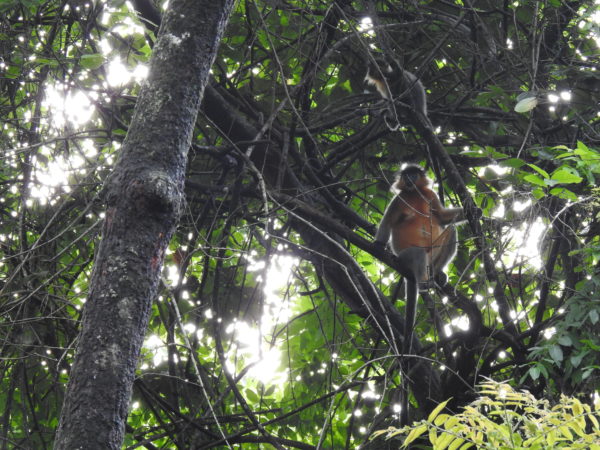
Capped Lagurs
Almost a three hour drive from Guwahati, the national park is managed under the administration of the Assam Forest Department / Bodoland Territorial Council. As we enter the park, which spreads across 500 sq. km, you cannot help but notice the immediate change in landscape. Thick forests with old, tall trees, and dense vegetation make it difficult in places to get a glimpse of the forest floor.

The Indian One-horned Rhinoceros we spotted
The experience of entering this exquisite landscape had still not sunk in, when suddenly, within a few minutes we witnessed a One-horned Rhinoceros at a distance. A Common Myna perched on top of the Rhino who was busy feeding; this was exciting as it was my first sighting of a wild Rhino. After a reasonable amount of time spent admiring the Rhino, we decided to move ahead. These mega-herbivores act as ecological engineers in parks such as this, shaping the wilderness by assisting multiple species thrive in various ways. An example could be birds that feed off parasites on the Rhino’s body, and the various insects and snails that are found on the Rhino skin depend on it for an easy meal. Rhino dung is known to form an eco-system of its own as they harbor various beetles and moths that are attracted to the dung.
On our way further into the national park we also got to see Capped Langurs, a Crested Serpent Eagle, Jungle Mynas, Asian Emerald Dove, Pin-tailed Pigeon, Greater Yellownape, Orange-breasted Pigeons, Lesser Coucal and the Great Hornbill.
Overnight, we stayed at Mathanguri. Overlooking River Manas and with Bhutan on the other bank, the view was otherworldly. Tokay Geckos are a common sight in such landscapes, but although we were on the watch out for one, we were not able to find any.
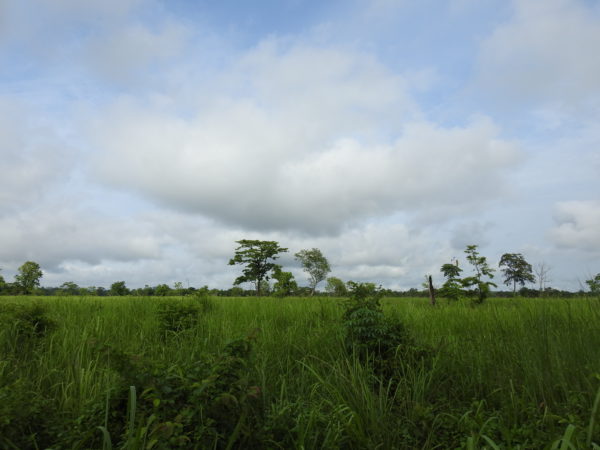
Elephant Grass
The next day, against the odds of a downpour we set out to see more of the park. Standing next to elephant grass that grows up to and more than 7 ft in favorable conditions can be awe inducing. It can easily hide an elephant! During the drive around the park we also got to see the rarely seen Bengal Florican fly by, which was definitely a major highlight. These birds are one of the rarest members in the Bustard order, with less than a 100 individuals remaining in the wild. Some of the biggest threats these birds face are agriculture and hunting. One of the most fascinating behaviors they are known for is their remarkable mating ritual, when males competitively display in groups. The male floricans perform in full view of other males, a dance-off in which they jump into the air and flutter back down whilst humming.
With rain pouring down, our chances of seeing any more wild animals was definitely reduced, besides, of course a leech that clung to my neck! This was again a first-time experience.
The forest department wholly manages the National Park. “We prioritize wildlife protection over everything here, the frontline staff within the national park also protect the camps, investigate poaching incidents and other such emergencies,” said Assistant Conservator of Forests (ACF), Manas National Park, Mr. Abbas Dewan. The park is patrolled by foot, by road and water. The authorities are also authorized to shoot if necessary, he added.
According to authorities, a recent poaching incident where they were able to nab tiger poachers and get a confession from them was a big win towards combatting wildlife trade. Another recent incident involved the rescue of an abandoned elephant calf, who could not catch up with her mother crossing a raging river, and was ultimately stranded in the river. The authorities worked tirelessly to rescue the little one and plan on releasing the elephant back in the wild, once it is able to sustain itself.
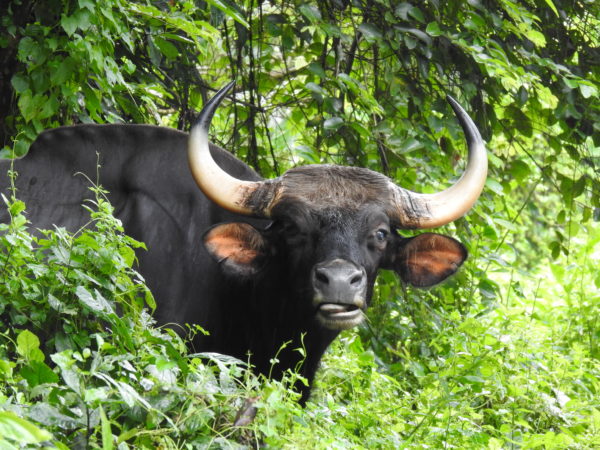
Gaur spotted in Manas National Park
Other challenges in Manas National Park are timber smuggling, although there has been a drastic decline in such practices, with the officials always on alert, said Abbas.
With the prominence Manas National Park has gained over the years, managing tourism while maintaining the park can be hard. The park is divided into two zones, one where tourists are allowed and the other, which is off limits. The national park is closed from mid-May to September. Tourism is regulated by sticking to 30 vehicles in the morning and 30 in the evening during visiting season.
The people who live near and around Manas, depend on the resources available to them from the park. In order to support these folks, an NGO called Aaranyak, has started providing alternative means of livelihood, encouraging SHGs (Self Help Groups) to manage vital needs, activities of the community.
As I came back from Manas, all I hope is that it stays protected. At a time when species are going extinct and forests disappearing at a scary rate, places like Manas hold some hope. A national park where maintaining the integrity of the natural area is valued above all. I am definitely looking forward to visiting again.
Written by Anisha Iyer